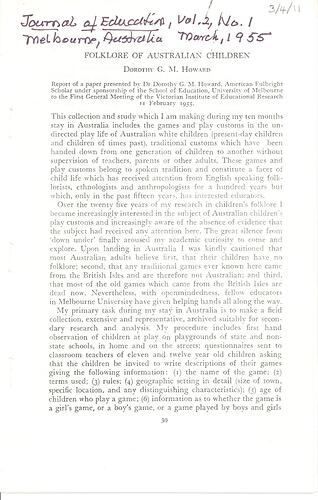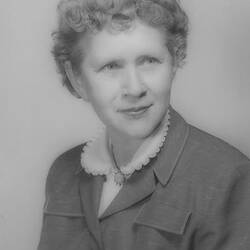Summary
Game names (and type): 'He', 'It', 'Oranges and Lemons', 'Stag Knife', 'Mumble Peg', 'Australian Dingo', 'British Bulldog', 'Red Rover', 'Bunny Hole', 'Castles', 'Big Ring', 'Little Ring' (chasing games), Knucklebones (knucklebones, use jacks)
Alternative game type: running games, imaginary play, play with equipment/props
Article titled 'Folklore of Australian Children' written by Dr Dorothy Howard and published in the Journal of Education in March 1955. The article is a report of a paper presented by Dr Howard to the First General Meeting of the Victorian Institute of Education Research on 11 February 1955. Dr Howard discusses the aim of her research project to assemble a field collection representing the games and play customs of Australian children. She describes her methodology which involves the analysis of her personal observations, questionnaires, secondary sources, and interviews with children, teachers, and adults reminiscing on their childhood play. Dr Howard reports on her preliminary findings, which indicate considerable regional variety and historical change in the play ways of Australian children. More importantly, she argues that folk tradition still exists in the play of Australian children to a far greater extent that previously supposed. Dr Howard goes onto discuss the meaning and origins of the term 'folklore', the establishment of Folklore Societies and the recognition of children's games as a specific area of folklore study. She concludes by reflecting on the perpetually changing nature of tradition and thereby, children's play customs.
One of a collection of publications about children's folklore written by Dr Dorothy Howard. Dr Howard came to Australia in 1954-55 as an American Fulbright scholar to study Australian children's folklore. She travelled across Australia for 10 months collecting children's playground rhymes, games, play artefacts, etc. The original fieldwork she collected during this period is held in the Australian Children's Folklore Collection (ACFC) at Museum Victoria and includes index cards, letters and photographs.
Physical Description
Article with typed black text printed on paper. Six, unbound pages printed on one side only. Handwritten annotation in black ink on first page.
More Information
-
Collection Names
Australian Children's Folklore Collection, Dorothy Howard Collection
-
Collecting Areas
-
Acquisition Information
Cultural Gifts Donation from Dr June Factor, 18 May 1999
-
Acknowledgement
Donated through the Australian Government's Cultural Gifts Program.
-
Collector
-
Author
-
Publisher
Journal of Education, Melbourne, Greater Melbourne, Victoria, Australia, Mar 1955
-
Organisation Named
University of Melbourne (The), Melbourne, Greater Melbourne, Victoria, Australia
-
Person Named
William J. Thoms, England, Great Britain, circa 1846
Dr. Howard cites William John Thoms, the writer credited with coining the term 'folklore' in 1846 and one of the founders of The Folk-Lore Society in England. -
Person Named
Dr R. S. Culin, circa 1902
Dr. Howard cites Dr. R. S. Culin's research of the jumping, hopping and leaping traditions of Indigenous peoples of Northern America circa 1902. -
Classification
-
Category
-
Discipline
-
Type of item
-
Overall Dimensions
138 mm (Width), 216 mm (Height)
Orientation: portrait
-
Keywords


